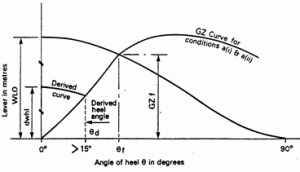Transport Publication TP 13313 E
- Table of Contents
- Introduction
- Definitions
- Application
- Construction and Structural Strength
- Stability
- Freeboard and Freeboard Marking
- Watertight &Watertight Integrity
- Water Freeing Arrangements
- Bilge Systems
- Fluid Systems
- Machinery
- Electrical Systems
- Steering Gear
- Fire Safety
- Life Saving and Emergency Equipment
- Communication Equipment
- Navigation Equipment
- Anchors and Cables
- Miscellaneous Marine Equipment
- Accommodation
- Protection of Personnel
- Appendix A: Sample Stability Information Booklet
- Section 1: Operational Information
- Section 2: Technical Data and Loading Conditions
- Section 3: Reference Information
3.1 Intact Stability
3.1.1 The centre of gravity ( KG ) of the ship should be established by an inclining experiment and curves of statical stability ( GZ curves) calculated for the following conditions:
- b) loaded departure, 100% consumables
- c) loaded arrival, 10% consumables.
3.1.2 For each of the conditions listed in 3.1.1, the righting arms curve should have a positive range of not less than 90 degrees. A minimum positive range of the righting arms curve for a ship of length smaller than 24 m may be determined by the formula:
90° + 25° x (24 - L ) ÷ 9,
however, a positive range of less than 90 degrees may be considered subject to operational limitations.
3.1.3 In addition the angle of steady heel obtained from the intersection of a "derived wind heeling lever" curve with either of the GZ curves referred to in sub paragraph 3.1.1 above should be greater than 15 degrees (see Figure 2)
Figure 2: Stability Curves
In Figure 2
‘ dwhl ’ = the "derived wind heeling lever" at any angle Θ degrees.
= 0.5 x WLO x Cos1..3Θ
where WLO = GZf / Cos1..3 Θf
Noting that:
WLO - is the magnitude of the actual wind heeling lever at 0 degrees which would cause the ship to heel to the ‘downflooding angle’ ( Θf or 60 degrees whichever is least).
If the use of some other angle, between the downflooding angle and 40 degrees, would result in a greater value of the maximum steady heel angle, this may be used as an alternative to Θf ,
GZf - is the lever of the ship's GZ curve at the ‘downflooding angle’ ( Θf ) or 60 degrees whichever is least,
Θd - is the angle at which the ‘derived wind heeling’ curve intersects the GZ curve. (If Θd is less than 15 degrees the ship will be considered to have insufficient stability for the purpose of this Standard).
Θf - the ‘downflooding angle’ is deemed to occur when openings having an aggregate area, in square metres, greater than:
ship's displacement in tonnes / 1500
are immersed. Moreover, it is the angle at which the lower edge of the actual opening which results in critical flooding becomes immersed.
3.1.4 All openings regularly used for crew access and for ventilation should be considered when determining the downflooding angle. No opening, regardless of size, which may lead to progressive flooding should be immersed at an angle of heel of less than 40 degrees. Air pipes to tanks can, however, be disregarded.
3.1.5 If as a result of the immersion of openings in a deckhouse a ship cannot meet the required standard, those deckhouse openings may be ignored and the openings in the weather deck protected by this deckhouse may be used instead to determine Θf . In such cases the GZ curve should be derived without the benefit of the buoyancy of the deckhouse.
3.1.6 Provided the ship complies with the requirements of subparagraphs 3.1.1, 3.1.2 and 3.1.3 and that it is sailed with an angle of heel which is no greater than the ‘derived angle of heel’, it should be capable of withstanding a wind gust equal to 1.4 times the actual wind velocity ( i.e. twice the actual wind pressure) without immersing the ‘downflooding openings’, or heeling to an angle greater than 60 degrees.
3.1.7 A ship having a positive range of righting arms smaller than 90 degrees may have its effective range of stability significantly reduced in the event of steadily increasing wind that may lead to capsizing at the angle of heel for which the heeling arms curve becomes tangent to the righting arms curve. Ships with such stability characteristics should have an appropriate warning note included in the stability guidance for the Master.
3.2 Stability Information Booklet
3.2.1 A ‘Stability Information Booklet’ with its content, form and presentation based on the model booklet given in Appendix A should be placed on board for the guidance of the master.
3.2.2 This Booklet should include details of the maximum steady angle of heel for the worst sailing condition which is to be calculated in accordance with subparagraph 3.1.3.
3.2.3 The Booklet should also include curves of maximum recommended steady angle of heel for the prevention of downflooding in the event of squall conditions. Details of the development of such curves are given in Appendix A.
3.2.4 It is recommended that a direct copy of the Curves of Maximum Steady Heel Angle to Prevent Downflooding in Squalls taken from the stability booklet, be mounted on a ship in a suitable position for the ready references of a crew.
3.3 Inclining Experiment
3.3.1 A general description of the experiment should be presented with details of the personnel responsible, prevailing conditions, procedure and equipment used, as well as precautions to be taken to ensure accuracy.
3.3.2 Successful inclining of a sailing ship requires conditions with little or no wind because of significant windage of the rig.
